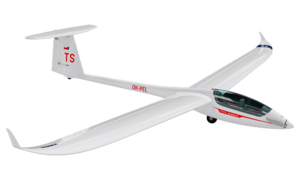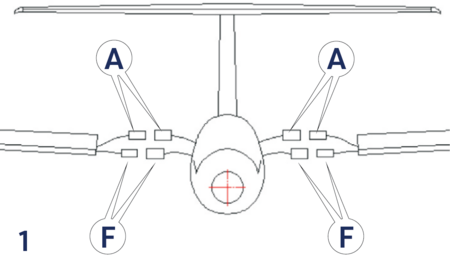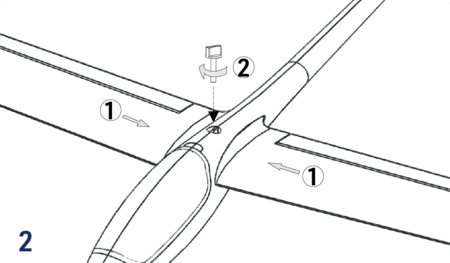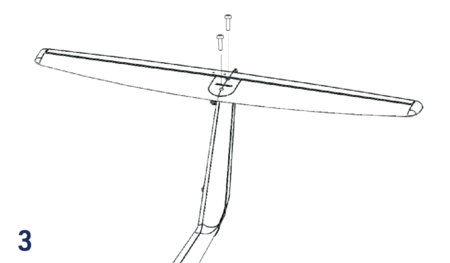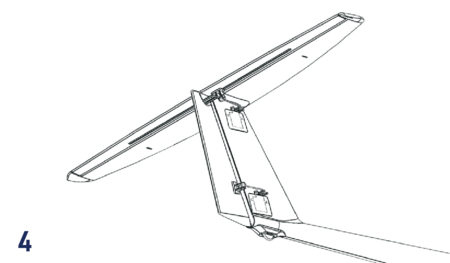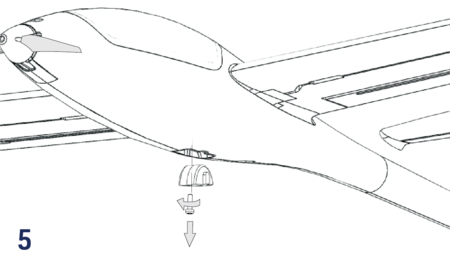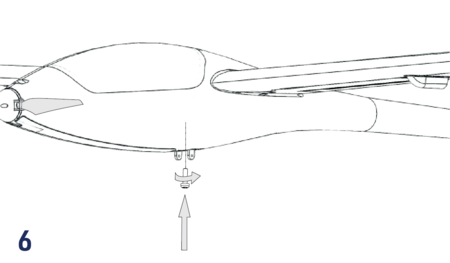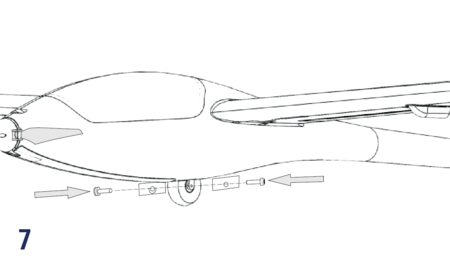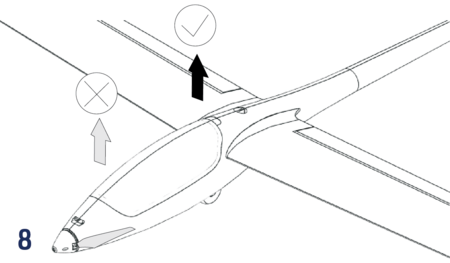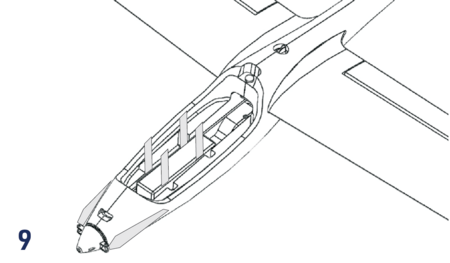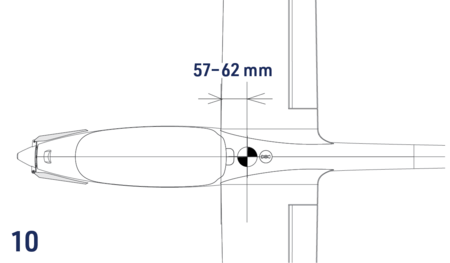KAVAN HPH 304TS TwinShark - Manuel d'instruction
Introduction
Félicitations pour votre achat du modčle semi-maquette du planeur HPH 304TS Twin Shark. Vous allez commencer ŕ assembler un modčle fabriqué ŕ partir d'une mousse EPO (polyoléfine expansée) pratiquement incassable, propulsé par un puissant moteur brushless et une batterie LiPo légčre. Tous ceux qui ont déjŕ maîtrisé le pilotage d'un "Trainer" complet – avec ailerons, gouverne de profondeur, gouverne de direction et contrôle des gaz – apprécieront ce magnifique planeur haute performance.
KAV02.8077 KAVAN 304TS TwinShark
HPH 304TS Twin Shark – un planeur tchčque aux racines allemandes
En 1962, Eugen Hänle a fondé la Glasflügel Segelflugzeugbau GmbH, qui est rapidement devenue célčbre en tant que premičre entreprise ŕ produire en grande série des planeurs en fibre de verre. Les conceptions de Glasflügel ont toujours été reconnues pour leurs solutions innovantes, devenues des caractéristiques standards des planeurs modernes : systčmes d'assemblage rapide pour les ailes et les empennages, combinaisons de volets d'aérofreins au bord de fuite, conception pratique des cockpits et des systčmes de contrôle, et bien d'autres. Malheureusement, aprčs la mort prématurée du fondateur dans un accident d'avion en 1975, l'entreprise a rencontré des difficultés financičres. Elle a finalement été dissoute en 1982.
Au milieu des années 1990, une jeune entreprise tchčque nommée HPH, déjŕ reconnue comme fabricant de modčles réduits de qualité muséale, a relancé la production de l'un des derniers planeurs conçus par Glasflügel : le type 304. L'usine de Kutná Hora, en Bohęme centrale, a débuté avec le HPH 304CZ fabriqué ŕ partir des moules et gabarits originaux, avant de le faire évoluer vers le HPH 304C Wasp de 15 mčtres, conforme ŕ la classe FAI. En 2006, ils ont introduit un tout nouveau design de la classe de 18 mčtres, nommé HPH 304S Shark, et enfin, en 2017, le planeur biplace de 20 mčtres, le HPH 304TS Twin Shark.
Avant de commencer
- Si vous n'ętes pas un pilote RC expérimenté, prévoyez qu'un pilote pleinement compétent vérifie votre modčle terminé et vous aide lors de vos premiers vols. Bien que nous ayons essayé de vous fournir un manuel d'instructions complet, les modčles RC sont assez compliqués, et un modéliste expérimenté peut rapidement examiner votre modčle pour s'assurer que vos premiers vols seront couronnés de succčs.
- Veuillez assembler votre modčle exactement selon ces instructions. N'essayez pas de modifier ou de changer votre modčle de quelque maničre que ce soit, car cela pourrait altérer ses caractéristiques de vol.
- Avant de commencer, veuillez vérifier l'ensemble du contenu de ce kit pour vous assurer qu'aucune pičce n'est manquante ou endommagée. Cela vous aidera également ŕ vous familiariser avec chaque composant de votre avion. Si vous constatez que certaines pičces sont manquantes ou endommagées, veuillez contacter immédiatement votre revendeur pour un remplacement.Remarque: Votre revendeur ne peut pas accepter le retour du kit si la construction a commencé.
- Faites un montage ŕ blanc de chaque pičce avant de la coller en place. Assurez-vous d'utiliser la bonne pičce et qu'elle s'adapte correctement avant de procéder ŕ l'assemblage. Aucune colle ne peut compenser un mauvais ajustement.
- Le manuel contient un dessin indiquant la position par défaut du centre de gravité (CG) et les débattements recommandés des gouvernes. Il est essentiel de respecter la position recommandée du CG pour le premier vol, sinon le modčle pourrait ętre instable, difficile ŕ contrôler, voire incapable de voler ! Par la suite, vous pourrez affiner la position du CG pour l'adapter ŕ votre style de pilotage et ŕ vos compétences.
Précautions
Ce modčle RC n'est pas un jouet. Manipulez-le avec précaution et suivez scrupuleusement les instructions de ce manuel.
Assemblez ce modčle en suivant strictement ces instructions. NE PAS modifier NI altérer le modčle. En cas de non-respect, la garantie sera automatiquement annulée. Suivez les instructions pour obtenir un modčle sűr et solide ŕ la fin de l’assemblage.
Les enfants de moins de 14 ans doivent utiliser le modčle sous la supervision d’un adulte.
Assurez-vous que le modčle soit en parfait état avant chaque vol, en vérifiant que tout l'équipement fonctionne correctement et que la structure du modčle est intacte.
Ne faites voler le modčle que par des jours de brise légčre et dans un endroit sécurisé, loin de tout obstacle.
Précautions et avertissements de sécurité
- Un avion RC n'est pas un jouet ! Une mauvaise utilisation peut causer des blessures graves et des dommages matériels. Volez uniquement dans un espace sécurisé, en respectant toutes les instructions et recommandations de ce manuel. Attention ŕ l’hélice ! Gardez les objets pouvant se coincer dans l’hélice (vętements amples, crayons, tournevis) ŕ distance de celle-ci lorsqu’elle est en mouvement. Assurez-vous que les mains et visages, les vôtres et ceux des autres, sont éloignés de l’hélice en rotation.
- En tant qu’utilisateur de ce produit, vous ętes seul responsable de son utilisation de maničre ŕ ne pas vous mettre en danger, ni autrui, ni causer de dommages au produit ou aux biens d’autres personnes. Ce modčle est contrôlé par un signal radio, susceptible de subir des interférences provenant de diverses sources échappant ŕ votre contrôle. Ces interférences peuvent entraîner une perte momentanée de contrôle. Il est donc recommandé de toujours maintenir une distance de sécurité autour de votre modčle dans toutes les directions, afin de minimiser les risques de collisions ou de blessures.
- Ne faites jamais fonctionner votre modčle avec les batteries de l'émetteur déchargées.
- Faites toujours fonctionner votre modčle dans une zone dégagée, loin des lignes électriques, des voitures, de la circulation et des personnes. Évitez d'utiliser votre modčle dans des zones peuplées oů des blessures ou des dommages pourraient survenir.
- Suivez attentivement les instructions et les avertissements concernant cet équipement ainsi que pour tout le matériel de support optionnel (chargeurs, batteries rechargeables, etc.) que vous utilisez.
- Gardez tous les produits chimiques, petites pičces et tout matériel électrique hors de portée des enfants.
- L'humidité endommage l'électronique. Évitez tout contact avec l'eau pour les équipements qui ne sont pas spécifiquement conçus et protégés ŕ cet effet.
- Le modčle est principalement fabriqué en plastique : il n'est pas résistant au feu. Il ne doit pas ętre exposé ŕ des températures élevées, sinon une déformation sévčre de la structure en mousse ou d'autres dommages peuvent survenir.
Specification
| Wingspan | 2700 mm |
| Length | 1285 mm |
| Wing area | 45 dm² |
| Weight | 1680 g |
| All–up weight | 1950–2050 g |
| Motor | C3548-750 |
| ESC | KAVAN R–50SB SBEC |
| Propeller | 11×8" |
Set contents
- Almost ready-to-fly model of a sailplane with the brushless motor, speed controller and servos installed, instruction manual.
You will also need
- At least 7-channel RC set, 14.8 V 2600–3300 mAh LiPo flight pack.
- Regular modeller’s tools – modeller’s knife, screwdrivers, pliers etc.
Model assembly
- Connect the aileron (A) and flap (F) servo cables to the corresponding extension cables in the wing opening in the fuselage. Double-check the correct connection. (Fig. 1)Note: The kit is supplied with Y-cables for ailerons and flaps so you can use even the most basic 6-channel radios to control your TwinShark. If you intend to use independent control of aileron and flap servos and an advanced computer radio, you will have to replace the default Y-cables with four 25–30 cm extension cables.
- Insert the wing halves into the fuselage and secure with the M6 nylon bolt. (Fig. 2)
- Attach the horizontal tailplane to the top of the fin and secure with two M3×10 mm screws. (Fig. 3)
- Attach the elevator push rod (the elevator servo is installed in the fin) to the elevator horn. (Fig. 4)
Your TwinShark is fitted for the belly landing as supplied. You might wish to add the undercarriage. - Remove the screw and the foam filler from the landing wheel bay. (Fig. 5)
- Install the wheel yoke using the same screw into the wheel bay. (Fig. 6)
- Insert the wheel into the yoke, attach the dummy undercarriage doors from both sides of the yoke and secure with two screws. (Fig. 7)
- The flight pack is to be placed in the bay in the centre of the cockpit. Use a hook-and-loop tie to fasten it. You can place your receiver (secured with a strip of hook-and-loop or double-sided foam tape) behind the flight pack. The ESC is to be secured in the same way along the flight pack. Connect the servos and your ESC to the receiver. Deploy the antennas so their active parts are square to each other (if you are using a receiver featuring diversity antennas). With your radio on, set the servos to the neutral position (sticks and trims centred) and fasten the setting screws of the pushrod connectors on the elevator and rudder servo arms. Perform the throttle range calibration of the ESC as described in the attachment of this manual. (Fig. 8+9)
- Attach the canopy.
RC set installation and preflight check
- Referring to the instruction manual of your radio carefully hook up the onboard electronics.
- Once everything has been correctly connected, turn on your transmitter and plug in the flight pack. Check the neutral positions and throws of all control surfaces. If you need to make the control surface throws smaller, simply move the pushrod closer to the centre on the servo arm or move it far from the control surface on the control horn. And vice versa.
| Low rate | High rate | |
| Ailerons | 15 mm up/8 mm down | 20 mm up/ 10 mm down |
| Ailerons (Butterfly) | 20 mm up | 20 mm up |
| Ailerons (Thermal) | 3 mm down | 3 mm down |
| Ailerons (Speed) | 3 mm up | 3 mm up |
| Elevator | ± 9 mm | ± 12 mm |
| Elevator (Butterfly) | 1–3 mm down | 1–3 mm down |
| Rudder | ± 25 mm | ± 35 mm |
| Flaps | 8 mm up/15 mm down | 8 mm up/15 mm down |
| Flaps as Ailerons | 7 mm up/3.5 mm down | 10 mm up/5 mm down |
| Flaps (Butterfly) | 20 mm down | 20 mm down |
| Flaps (Thermal) | 4 mm down | 4 mm down |
| Flaps (Speed) | 3 mm up | 3 mm up |
- The "Low rate" recommended control surface throws are suitable for a less skilled pilot and regular soaring. The "High rate" setting allows an experienced pilot to explore the full capabilities of his model. The aileron differential (aileron down deflection reduced to 50% of up deflection) is only possible with a computer radio.
- Check the direction of rotation of the propeller. If it was incorrect, simply swap two of the three wires between the ESC and motor or program the ESC (refer to the ESC manual).
- Check the correct position of the centre of gravity (CG): 57–62 mm behind the leading edge of the wing (Fig. 10). Adjust the CG position by moving the flight pack - if you could not reach the recommended position, do not hesitate to add an appropriate amount of lead to the nose or tail. An extra couple of grams won’t spoil the flying characteristics - but the incorrect CG position is a killer.
- Fully charge your flight pack and transmitter batteries, check the proper function of your radio and perform the range check of your radio according to its instruction manual. The range has to be almost the same with the motor off and at full throttle (no more than a 10% decrease is acceptable). DO NOT try to fly unless the range check is 100% successful.
Flying
The test flying and fine-tuning is pretty much straightforward, there will be no surprise for a medium-advanced pilot who is supposed to fly this model.
Recycling and Waste Disposal Note (European Union)

Electrical equipment marked with the crossed-out waste bin symbol must not be discarded in the domestic waste; it should be disposed of via the appropriate specialised disposal system. In the countries of the EU (European Union) electrical devices must not be discarded via the normal domestic waste system (WEEE - Waste of Electrical and Electronic Equipment, Directive 2012/19/EU). You can take your unwanted equipment to your nearest public collection point or recycling centre, where it will be disposed of in the proper manner at no charge to you. By disposing of your old equipment in a responsible manner you make an important contribution to the safeguarding of the environment!
EU Declaration of Conformity (European Union)

Hereby, KAVAN Europe s.r.o. declares that this HPH 304TS TwinShark model and the included electronic and electric devices are in compliance with the requirements of relevant European directives and harmonized norms. The full text of the Declaration of Conformity is available at www.kavanrc.com/doc/.
Guarantee
The KAVAN Europe s.r.o. products are covered by a guarantee that fulfils the currently valid legal requirements in your country. If you wish to make a claim under guarantee, please contact the retailer from whom you first purchased the equipment. The guarantee does not cover faults which were caused in the following ways: crashes, improper use, incorrect connection, reversed polarity, maintenance work carried out late, incorrectly or not at all, or by unauthorised personnel, use of other than genuine KAVAN Europe s.r.o. accessories, modifications or repairs which were not carried out by KAVAN Europe s.r.o. or an authorised KAVAN Europe s.r.o., accidental or deliberate damage, defects caused by normal wear and tear, operation outside the Specification, or in conjunction with equipment made by other manufacturers. Please be sure to read the appropriate information sheets in the product documentation.
